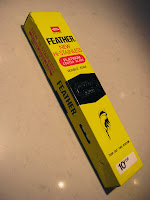 The Decimo is one of Pilot's capless fountain pens. For those wondering . . . "capless" = "retractable" in this context. The capless mechanism is identical to that used in the well-known Vanishing Point fountain pen by Pilot. I acquired a dark blue version with silver (rhodium) trim; ordered from an online vendor based in Japan. I've seen these offered on the Internet within the range of US$120 to US$260, and I can't explain the price variation. I suspect that the lower prices may reflect a product with a lower quality nib component, that the higher prices may reflect a limited edition version, or both.
The Decimo is one of Pilot's capless fountain pens. For those wondering . . . "capless" = "retractable" in this context. The capless mechanism is identical to that used in the well-known Vanishing Point fountain pen by Pilot. I acquired a dark blue version with silver (rhodium) trim; ordered from an online vendor based in Japan. I've seen these offered on the Internet within the range of US$120 to US$260, and I can't explain the price variation. I suspect that the lower prices may reflect a product with a lower quality nib component, that the higher prices may reflect a limited edition version, or both. I'm glad that I ordered the dark blue version. The blue is deep and slightly shimmery, without looking cheesy or tacky. The silver trim is brightly plated, and it matches the plating of the nib. If I'm being honest, I think a satin silver or nickel trim would look better with the blue body, but then the exterior trim wouldn't match the nib. The fit and finish of this pen is very good, and I have no complaints in that regard.
I'm glad that I ordered the dark blue version. The blue is deep and slightly shimmery, without looking cheesy or tacky. The silver trim is brightly plated, and it matches the plating of the nib. If I'm being honest, I think a satin silver or nickel trim would look better with the blue body, but then the exterior trim wouldn't match the nib. The fit and finish of this pen is very good, and I have no complaints in that regard.I chose the Decimo over its famous cousin (the Vanishing Point) because the Decimo is a little more compact in size and I thought it would be a better fit my child-like hand. I don't own a Vanishing Point and, therefore, can't do a hand-by-hand comparison, but my online research (which is always 100% accurate because everything found on the Internet is the truth) indicates that the Decimo is, in fact, less bulky and thinner in the grip area.
Speaking of the grip area, the pocket clip is attached to the nib end of the pen so that the nib doesn't leak during pocket carry (unless the carrier likes to walk on his/her hands, is a trapeze performer, or is an astronaut). Some users complain that the clip interferes with their fingers, but the clip doesn't bother me at all. In fact, I like how the clip also serves to align the pen in the hand such that the nib is properly oriented for writing.
The retractable nib mechanism is an engineering marvel. OK, it's not up to par with the Hoover Dam, but it's still pretty slick. The Decimo works just like a typical clicky style ballpoint pen: click once to extend the nib; click again to retract it. This is great for use at work, where I often jot down quick notes and annotate documents. In that typical workplace scenario, it's a hassle to frequently uncap and recap a traditional fountain pen to prevent it from drying out.
The following picture shows the business end of the Decimo with the nib retracted. The picture doesn't reveal the trap door thingy that covers and seals the nib inside the body of the pen. The door really works well . . . the nib has never dried out on me (although I haven't let the pen sit unused for more than a week).
 |
| In |
 |
| Out |
Speaking of the nib . . . the nib units of Pilot's capless pens (including the Decimo and the Vanishing Point) are interchangeable, and are offered by several vendors. I might obtain a medium nib unit if $70.00 magically appears in my wallet some day. The nib unit includes the nib, the feed, and a tube that accommodates Pilot ink cartridges (which only fit Pilot fountain pens) and certain Pilot ink converters (Pilot's CON-70 converter does not fit). The pen also comes with a metal sleeve for use with ink cartridges. The sleeve protects the cartridge and provides support for the actuation mechanism.
 |
| Nib Unit + Ink Cartridge Sleeve |
After more than six months of almost daily use, I can honestly say that I love this pen. The nib is rhodium plated 18 karat gold, and it has a little bit of give. I can't say whether or not it is "soft" per se, because I've never written with a truly soft nib. I do like the feel and smoothness of the nib, and the unusual shape/size of the nib has little to no impact on the writing experience. The performance of the nib is right up there with my other "good" fountain pens.
Moreover, the size and weight of the pen is nearly perfect for me, and the retracting mechanism works as expected and without any problems. I don't have any legitimate complaints about this pen, other than the high price. If it were less expensive, I'd already have another one for my home office.
Here are some writing samples that I created soon after I received the Decimo:
 |
| Sample 1 |
 |
| Sample 2 |
 |
| Sample 3 |
This will probably be the last post of 2013. Happy New Year!














































